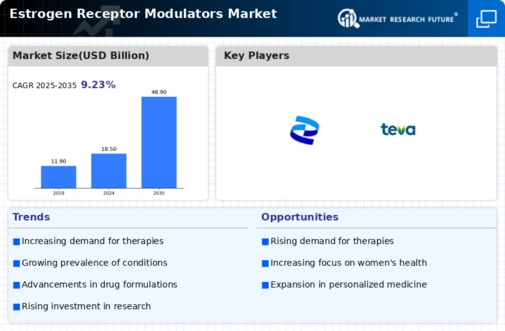Leading market players are investing heavily in research and development in order to expand their product lines, which will help the Estrogen Receptor Modulators market, grow even more. Market participants are also undertaking a variety of strategic activities to expand their footprint, with important market developments including new product launches, contractual agreements, mergers and acquisitions, higher investments, and collaboration with other organizations. To expand and survive in a more competitive and rising market climate, Estrogen Receptor Modulators industry must offer cost-effective items.
Leading players in the Estrogen Receptor Modulators (ERMs) market are actively engaged in research and development to enhance existing medications and develop novel compounds. These companies focus on obtaining regulatory approvals for new indications, expanding their product portfolios, and strengthening their market presence through strategic collaborations and partnerships. Additionally, efforts are directed towards addressing unmet medical needs, ensuring patient safety, and staying abreast of emerging technologies. The competitive landscape is characterized by a dynamic interplay of innovation, regulatory compliance, and market expansion strategies among key industry players.
Manufacturing locally to minimize operational costs is one of the key business tactics used by manufacturers in the Estrogen Receptor Modulators industry to benefit clients and increase the market sector. In recent years, the Estrogen Receptor Modulators industry has offered some of the most significant advantages to medicine. Major players in the Estrogen Receptor Modulators market, including General Mills Inc., Amway, Conagra Brands Inc., Cargill Incorporated, Abbott Laboratories, Kraft Foods Group Inc., and others, are attempting to increase market demand by investing in research and development operations.
AstraZeneca plc is a prominent entity in the Estrogen Receptor Modulators Market, renowned for its comprehensive range of innovative pharmaceutical solutions targeting hormone-related disorders. The company has solidified its position through a commitment to advancing treatment options for conditions such as breast cancer and osteoporosis. AstraZeneca plc emphasizes extensive research and development, consistently introducing cutting-edge therapies with a focus on patient outcomes. Through strategic partnerships and a presence, the company aims to broaden access to its advanced treatments. AstraZeneca plc also prioritizes ongoing clinical trials and collaborative efforts, striving to expand the applications of estrogen receptor modulators.
With a dedication to innovation, quality, and patient care, AstraZeneca plc continues to be a key driver in shaping the Estrogen Receptor Modulators Market.
Eli Lilly and Company is a pivotal figure in the Estrogen Receptor Modulators Market, celebrated for its comprehensive portfolio of transformative pharmaceutical solutions targeting hormone-related conditions. The company has established a robust presence by prioritizing innovative research and development, consistently introducing groundbreaking therapies for diseases like breast cancer and osteoporosis. Eli Lilly and Company places a strong emphasis on strategic collaborations and outreach, aiming to expand the accessibility of its advanced treatments. Moreover, the company's commitment to ongoing clinical trials and scientific partnerships underscores its dedication to advancing the applications of estrogen receptor modulators.
With a focus on patient-centric care, innovation, and impact, Eli Lilly and Company remains a key influencer in shaping the Estrogen Receptor Modulators Market.














Leave a Comment